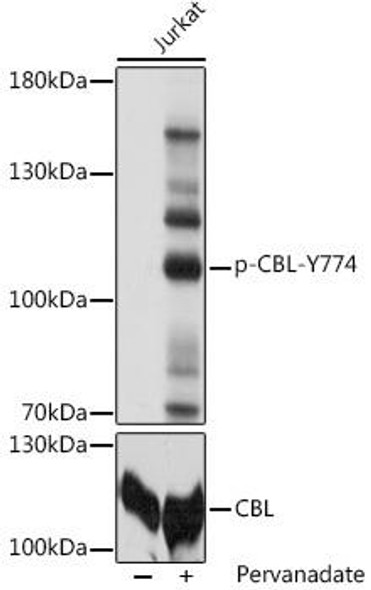Signal Transduction Antibodies 3
Anti-CBL Antibody (CAB0732)
- SKU:
- CAB0732
- Product Type:
- Antibody
- Reactivity:
- Human
- Reactivity:
- Mouse
- Reactivity:
- Rat
- Host Species:
- Rabbit
- Isotype:
- IgG
- Antibody Type:
- Polyclonal Antibody
- Research Area:
- Signal Transduction
Description
| Antibody Name: | Anti-CBL Antibody |
| Antibody SKU: | CAB0732 |
| Antibody Size: | 20uL, 50uL, 100uL |
| Application: | WB IHC IF |
| Reactivity: | Human, Mouse, Rat |
| Host Species: | Rabbit |
| Immunogen: | Recombinant fusion protein containing a sequence corresponding to amino acids 637-906 of human CBL (NP_005179.2). |
| Application: | WB IHC IF |
| Recommended Dilution: | WB 1:500 - 1:2000 IHC 1:50 - 1:100 IF 1:50 - 1:200 |
| Reactivity: | Human, Mouse, Rat |
| Positive Samples: | MCF7, SKOV3, Raji, Mouse thymus, Rat thymus |
| Immunogen: | Recombinant fusion protein containing a sequence corresponding to amino acids 637-906 of human CBL (NP_005179.2). |
| Purification Method: | Affinity purification |
| Storage Buffer: | Store at -20'C. Avoid freeze / thaw cycles. Buffer: PBS with 0.02% sodium azide, 50% glycerol, pH7.3. |
| Isotype: | IgG |
| Sequence: | LGST FSLD TSMS MNSS PLVG PECD HPKI KPSS SANA IYSL AARP LPVP KLPP GEQC EGEE DTEY MTPS SRPL RPLD TSQS SRAC DCDQ QIDS CTYE AMYN IQSQ APSI TESS TFGE GNLA AAHA NTGP EESE NEDD GYDV PKPP VPAV LARR TLSD ISNA SSSF GWLS LDGD PTTN VTEG SQVP ERPP KPFP RRIN SERK AGSC QQGS GPAA SAAT ASPQ LSSE IENL MSQG YSYQ DIQK ALVI AQNN IEMA KNIL REFV SISS PAHV AT |
| Gene ID: | 867 |
| Uniprot: | P22681 |
| Cellular Location: | Cell membrane, Cytoplasm |
| Calculated MW: | 99kDa |
| Observed MW: | 120kDa |
| Synonyms: | C-CBL, CBL2, FRA11B, NSLL, RNF55, CBL, c-Cbl |
| Background: | This gene is a proto-oncogene that encodes a RING finger E3 ubiquitin ligase. The encoded protein is one of the enzymes required for targeting substrates for degradation by the proteasome. This protein mediates the transfer of ubiquitin from ubiquitin conjugating enzymes (E2) to specific substrates. This protein also contains an N-terminal phosphotyrosine binding domain that allows it to interact with numerous tyrosine-phosphorylated substrates and target them for proteasome degradation. As such it functions as a negative regulator of many signal transduction pathways. This gene has been found to be mutated or translocated in many cancers including acute myeloid leukaemia, and expansion of CGG repeats in the 5' UTR has been associated with Jacobsen syndrome. Mutations in this gene are also the cause of Noonan syndrome-like disorder. |
| UniProt Protein Function: | Adapter protein that functions as a negative regulator of many signaling pathways that are triggered by activation of cell surface receptors. Acts as an E3 ubiquitin-protein ligase, which accepts ubiquitin from specific E2 ubiquitin-conjugating enzymes, and then transfers it to substrates promoting their degradation by the proteasome. Recognizes activated receptor tyrosine kinases, including KIT, FLT1, FGFR1, FGFR2, PDGFRA, PDGFRB, EGFR, CSF1R, EPHA8 and KDR and terminates signaling. Recognizes membrane-bound HCK, SRC and other kinases of the SRC family and mediates their ubiquitination and degradation. Participates in signal transduction in hematopoietic cells. Plays an important role in the regulation of osteoblast differentiation and apoptosis. Essential for osteoclastic bone resorption. The 'Tyr-731' phosphorylated form induces the activation and recruitment of phosphatidylinositol 3-kinase to the cell membrane in a signaling pathway that is critical for osteoclast function. May be functionally coupled with the E2 ubiquitin-protein ligase UB2D3. |
| NCBI Summary: | This gene is a proto-oncogene that encodes a RING finger E3 ubiquitin ligase. The encoded protein is one of the enzymes required for targeting substrates for degradation by the proteasome. This protein mediates the transfer of ubiquitin from ubiquitin conjugating enzymes (E2) to specific substrates. This protein also contains an N-terminal phosphotyrosine binding domain that allows it to interact with numerous tyrosine-phosphorylated substrates and target them for proteasome degradation. As such it functions as a negative regulator of many signal transduction pathways. This gene has been found to be mutated or translocated in many cancers including acute myeloid leukaemia, and expansion of CGG repeats in the 5' UTR has been associated with Jacobsen syndrome. Mutations in this gene are also the cause of Noonan syndrome-like disorder. [provided by RefSeq, Jul 2016] |
| UniProt Code: | P22681 |
| NCBI GenInfo Identifier: | 251757253 |
| NCBI Gene ID: | 867 |
| NCBI Accession: | P22681.2 |
| UniProt Secondary Accession: | P22681,A3KMP8, |
| UniProt Related Accession: | P22681 |
| Molecular Weight: | 99,633 Da |
| NCBI Full Name: | E3 ubiquitin-protein ligase CBL |
| NCBI Synonym Full Names: | Cbl proto-oncogene |
| NCBI Official Symbol: | CBL |
| NCBI Official Synonym Symbols: | CBL2; NSLL; C-CBL; RNF55; FRA11B |
| NCBI Protein Information: | E3 ubiquitin-protein ligase CBL |
| UniProt Protein Name: | E3 ubiquitin-protein ligase CBL |
| UniProt Synonym Protein Names: | Casitas B-lineage lymphoma proto-oncogene; Proto-oncogene c-Cbl; RING finger protein 55; RING-type E3 ubiquitin transferase CBLCurated; Signal transduction protein CBL |
| Protein Family: | E3 ubiquitin ligase |
| UniProt Gene Name: | CBL |
View AllClose










